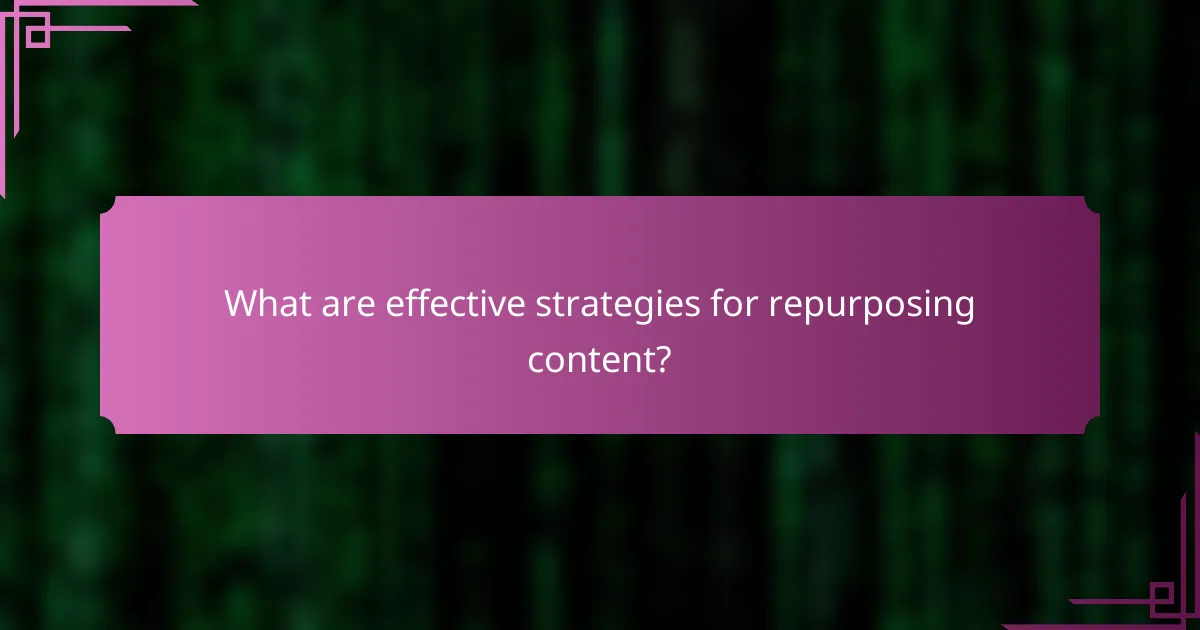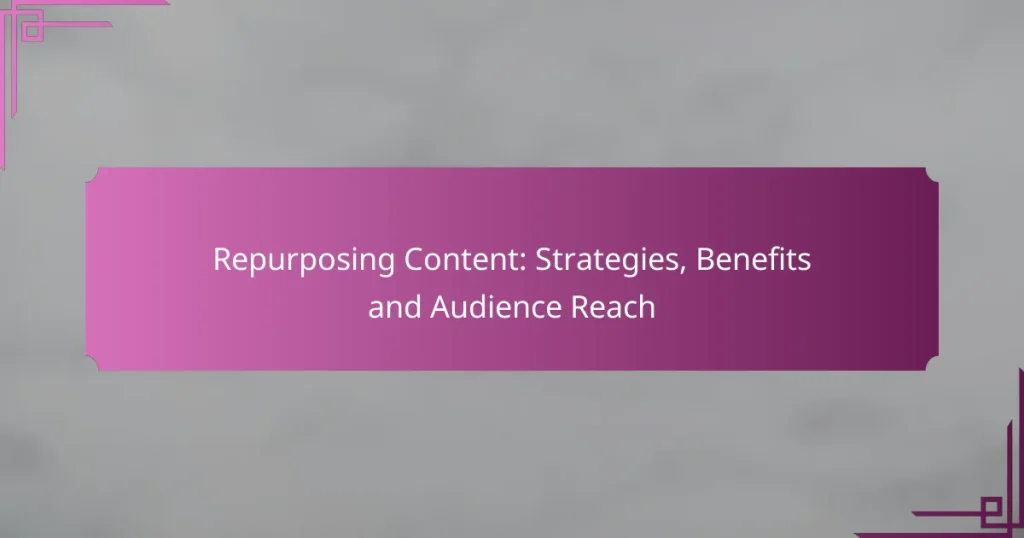Repurposing content is a strategic approach that allows businesses to maximize the value of their existing material while reaching a broader audience. By updating, transforming formats, and sharing across various platforms, companies can effectively engage diverse audience segments and enhance overall engagement. This method not only extends the lifespan of content but also reinforces key messages, making them more memorable for viewers.

What are effective strategies for repurposing content?
Effective strategies for repurposing content include updating existing material, shifting formats, targeting specific audiences, sharing across platforms, and optimizing for search engines. These methods enhance content longevity, broaden reach, and improve engagement with diverse audience segments.
Content updating
Content updating involves revising and refreshing existing articles or posts to ensure they remain relevant and accurate. This can include adding new information, correcting outdated facts, or improving the overall quality of the writing. Regular updates can significantly boost user engagement and search engine rankings.
For example, if you have a blog post about digital marketing trends from two years ago, revising it to include the latest statistics and insights can attract new readers and retain existing ones. Aim to update your top-performing content at least once a year.
Format shifting
Format shifting entails transforming content into different formats to reach various audience preferences. This could mean turning a blog post into a video, infographic, podcast, or social media post. Each format can appeal to different learning styles and consumption habits.
For instance, a detailed article can be summarized into a short video or an infographic that highlights key points. This approach not only diversifies your content portfolio but also maximizes the chances of engaging users across multiple platforms.
Audience targeting
Audience targeting focuses on tailoring repurposed content to meet the specific needs and interests of different audience segments. Understanding your audience demographics and preferences allows for more effective communication and engagement.
Consider creating variations of a single piece of content aimed at different groups. For example, a comprehensive guide on healthy eating can be adapted into a quick tips list for busy professionals and a detailed meal plan for families. This strategy ensures that your content resonates with a wider audience.
Cross-platform sharing
Cross-platform sharing involves distributing your repurposed content across various social media and online platforms to maximize visibility. Each platform has its unique audience and content style, so adapting your message accordingly is crucial.
For example, a blog post can be shared on Facebook with a catchy image, while a snippet can be tweeted with a link. Engaging with users on multiple platforms increases the chances of your content being seen and shared, enhancing overall reach.
SEO optimization
SEO optimization is essential when repurposing content to ensure it ranks well in search engine results. This involves using relevant keywords, optimizing meta tags, and ensuring that the content is structured for easy readability.
When updating or shifting formats, remember to include keywords that your target audience is searching for. Tools like Google Keyword Planner can help identify popular search terms. Regularly optimizing your content can lead to improved visibility and traffic over time.

What are the benefits of repurposing content?
Repurposing content offers numerous advantages, including maximizing the value of existing material and reaching a broader audience. By transforming content into different formats, businesses can engage various segments of their audience more effectively.
Increased audience reach
Repurposing content allows you to connect with diverse audience segments across multiple platforms. For instance, a blog post can be turned into an infographic, a video, or a podcast, each appealing to different preferences and consumption habits.
Consider sharing a single piece of content on social media, email newsletters, and your website. This multi-channel approach can significantly expand your reach and attract new followers who may not engage with your original format.
Cost efficiency
Creating new content can be time-consuming and costly. By repurposing existing material, you can save resources while still delivering valuable information to your audience. This strategy allows you to maximize your content creation budget.
For example, if you have a well-received webinar, consider breaking it down into smaller video clips or blog posts. This not only extends the life of your content but also provides fresh material without the need for additional investment.
Enhanced brand visibility
Repurposing content can significantly boost your brand’s visibility across various channels. When you present your content in multiple formats, it increases the likelihood of being discovered by new audiences.
Utilizing platforms like YouTube, Instagram, or LinkedIn to share repurposed content can enhance your brand’s presence. Each platform has its unique audience, and adapting your content accordingly can lead to greater recognition and engagement.
Improved SEO rankings
Repurposing content can positively impact your SEO rankings by creating more opportunities for backlinks and keyword optimization. When you distribute your content in various formats, it can attract different types of traffic to your website.
For instance, turning a blog post into a video can lead to increased shares and backlinks, which are crucial for improving your search engine visibility. Regularly updating and repurposing content can keep it relevant and help maintain or boost your rankings over time.

How can repurposing content improve audience engagement?
Repurposing content can significantly enhance audience engagement by presenting information in various formats that cater to different preferences. This strategy not only broadens reach but also reinforces key messages, making them more memorable for the audience.
Diverse content formats
Utilizing diverse content formats allows you to reach a wider audience. For instance, a single blog post can be transformed into a video, infographic, podcast, or social media posts. Each format appeals to different learning styles and preferences, increasing the likelihood of engagement.
Consider creating a series of short videos summarizing key points from a longer article. This can attract viewers who prefer visual content, while the original article remains available for those who want in-depth information.
Tailored messaging
Repurposing content enables you to tailor messaging for specific segments of your audience. By adjusting the tone, style, and focus of the content, you can address the unique needs and interests of different groups. For example, a technical article can be simplified for a general audience while maintaining a detailed version for industry professionals.
Use analytics to identify which topics resonate most with your audience. This data can guide how you adapt your messaging across various platforms, ensuring that each piece of content speaks directly to its intended audience.
Interactive elements
Incorporating interactive elements into repurposed content can boost engagement significantly. Features such as quizzes, polls, or clickable infographics encourage active participation, making the experience more engaging for users. This interaction can lead to higher retention of information and increased sharing.
For example, if you have an informative article, consider adding a quiz at the end to test readers’ knowledge. This not only reinforces the content but also invites users to engage more deeply, enhancing their overall experience.

What tools can assist in content repurposing?
Several tools can significantly enhance the process of content repurposing by streamlining design, scheduling, and analysis. Utilizing the right software can help you maximize the reach and effectiveness of your existing content across various platforms.
Canva for design
Canva is a user-friendly graphic design tool that allows you to create visually appealing content quickly. It offers a wide range of templates for social media posts, infographics, and presentations, making it easy to transform written content into engaging visuals.
To effectively use Canva, start by selecting a template that aligns with your brand’s aesthetic. Customize it with your text, images, and colors to ensure consistency. Remember to keep your designs simple and focused to maintain audience interest.
Hootsuite for scheduling
Hootsuite is a social media management platform that enables you to schedule posts across multiple channels. This tool helps you maintain a consistent posting schedule, which is crucial for maximizing audience engagement and reach.
When using Hootsuite, plan your content calendar in advance. Aim to post at optimal times based on your audience’s online behavior. Regularly review analytics to adjust your strategy and improve performance over time.
BuzzSumo for content analysis
BuzzSumo is a powerful content analysis tool that helps you identify trending topics and measure the performance of your repurposed content. By analyzing what resonates with your audience, you can refine your content strategy for better results.
Utilize BuzzSumo to track engagement metrics such as shares, likes, and comments. This data can guide your future content creation efforts, ensuring that you focus on topics that generate interest. Regularly assess your content’s performance to adapt and stay relevant in your niche.

